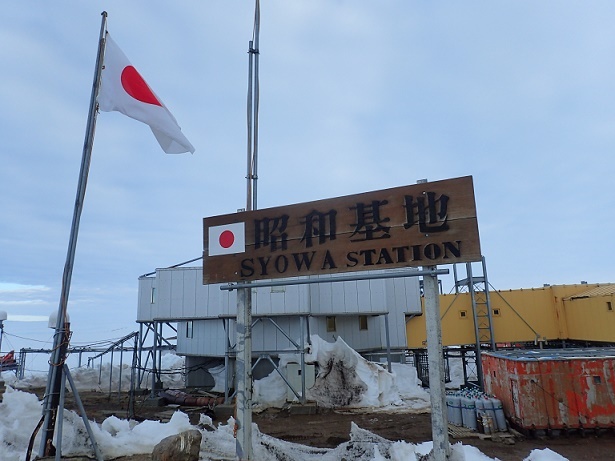Showa Base on:
[Wikipedia]
[Google]
[Amazon]
, sometimes alternately spelled Syowa Station, is a Japanese permanent research station on East Ongul Island in Queen Maud Land, Antarctica. Built in 1957, Showa Station is named for the era in the Japanese calendar during which it was established, the Shōwa period.
 Showa Station serves as a research outpost for astronomy, meteorology, biology and
Showa Station serves as a research outpost for astronomy, meteorology, biology and
Official website National Institute of Polar Research
Syowa Base Now!! (Japanese only)
OpenStreetMap
COMNAP Antarctic Facilities
COMNAP Antarctic Facilities MapShowa Research Station Amateur Radio Station 8J1RL
{{Authority control Outposts of Queen Maud Land Japanese Antarctic Program Buildings and structures completed in 1957 Prince Harald Coast 1957 establishments in Antarctica Historic Sites and Monuments of Antarctica
Overview
 Showa Station serves as a research outpost for astronomy, meteorology, biology and
Showa Station serves as a research outpost for astronomy, meteorology, biology and earth science
Earth science or geoscience includes all fields of natural science related to the planet Earth. This is a branch of science dealing with the physical, chemical, and biological complex constitutions and synergistic linkages of Earth's four spheres ...
s. It comprises over 60 separate buildings, large and small, including a 3-storey administration building, living quarters, power plant, sewage treatment facility, environmental science building, observatory, data processing facility, satellite building, ionospheric station, incinerator, earth science building, and radiosonde station. Also present are fuel tanks, water storage, solar panels, a heliport, water retention dam, and radio transmitter.
PANSY Incoherent Scatter Radar
Showa station is home to the Program of the Antarctic Syowa Mesosphere–Stratosphere–Troposphere/Incoherent Scatter (PANSY)incoherent scatter radar Incoherent scattering is a type of scattering phenomenon in physics. The term is most commonly used when referring to the scattering of an electromagnetic wave (usually light or radio frequency) by random fluctuations in a gas of particles (most o ...
, which took its first measurements in 2017.
Legacy
1957 Expedition
The station was founded by the inauguralJapanese Antarctic Research Expedition
The refers to a series of Japanese Antarctic expeditions for scientific research.
The first JARE expedition was launched in 1957 to coordinate with the International Geophysical Year. This was the team which left 15 dogs, including Taro and ...
in 1957. This expedition was airlifted out after a storm made deploying the second team impossible in February 1958. In January 1959, the third team returned to the station and found that, of 15 sled dogs that had been left by the previous team, two, Taro and Jiro
Taro (タロ; 1955–1970) and Jiro (ジロ; 1955–1960) were two Sakhalin Huskies which survived for eleven months in Antarctica after being left behind by the 1958 Japanese Antarctic Research Expedition. Due to poor weather conditions, the ex ...
, had survived.
Historic monument
Acairn
A cairn is a man-made pile (or stack) of stones raised for a purpose, usually as a marker or as a burial mound. The word ''cairn'' comes from the gd, càrn (plural ).
Cairns have been and are used for a broad variety of purposes. In prehis ...
and plaque at the station commemorate Shin Fukushima, a member of the 4th Japanese Antarctic Research Expedition, who died in October 1960 while carrying out his duties. The cairn, which contains some of his ashes
Ashes may refer to:
*Ash, the solid remnants of fires.
Media and entertainment Art
* ''Ashes'' (Munch), an 1894 painting by Edvard Munch
Film
* ''The Ashes'' (film), a 1965 Polish film by director Andrzej Wajda
* ''Ashes'' (1922 film), a ...
, was erected on 11 January 1961 by his colleagues. It has been designated a Historic Site or Monument (HSM 2) following a proposal by Japan to the Antarctic Treaty Consultative Meeting
russian: link=no, Договор об Антарктике es, link=no, Tratado Antártico
, name = Antarctic Treaty System
, image = Flag of the Antarctic Treaty.svgborder
, image_width = 180px
, caption ...
.
In popular culture
* Showa Station is the Antarctic destination of the protagonists of '' A Place Further than the Universe'', a 2018 Japanese anime series. * The monsterGhidorah
is a fictional monster, or ''kaiju'', which first appeared in Ishirō Honda's 1964 film ''Ghidorah, the Three-Headed Monster''. Although the name of the character is officially trademarked by Toho as "King Ghidorah", the character was originally ...
is located on the base - called "Outpost 32" - in the 2019 film '' Godzilla: King of the Monsters''
* Showa Station is depicted in the 1983 film '' Antarctica''.
Climate
The climate is classified as an Ice cap climate ( Köppen: EF), since there are no months where the average temperature exceeds .See also
* List of Antarctic research stations * List of Antarctic field camps * List of airports in Antarctica *Asuka Station
is a railway station located in Asuka, Takaichi, Nara, Japan, on the Kintetsu Railway Yoshino Line.
Lines
* Kintetsu Railway
** Yoshino Line
Platforms and tracks
Surroundings
*
*Takamatsuzuka Tomb
*Ishibutai Kofun
*Oni no Manaita, Oni ...
*Dome Fuji Station
Dome Fuji (ドームふじ ''Dōmu Fuji''), also called Dome F or Valkyrie Dome, is an Antarctic base located in the eastern part of Queen Maud Land at . With an altitude of above sea level, it is the second-highest summit or ''ice dome'' of ...
* Mizuho Station
*''Antarctica (1983 film)
is a 1983 Japanese drama film directed by Koreyoshi Kurahara and starring Ken Takakura. Its plot centers on the 1958 ill-fated Japanese scientific expedition to the South Pole, its dramatic rescue from the impossible weather conditions on the re ...
''
*'' A Place Further than the Universe''
References
External links
Official website National Institute of Polar Research
Syowa Base Now!! (Japanese only)
OpenStreetMap
COMNAP Antarctic Facilities
COMNAP Antarctic Facilities Map
{{Authority control Outposts of Queen Maud Land Japanese Antarctic Program Buildings and structures completed in 1957 Prince Harald Coast 1957 establishments in Antarctica Historic Sites and Monuments of Antarctica